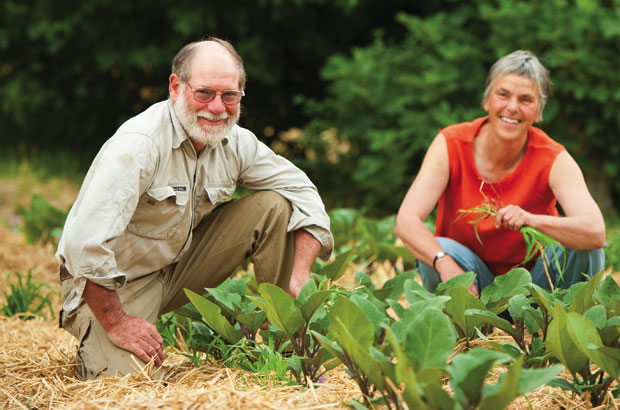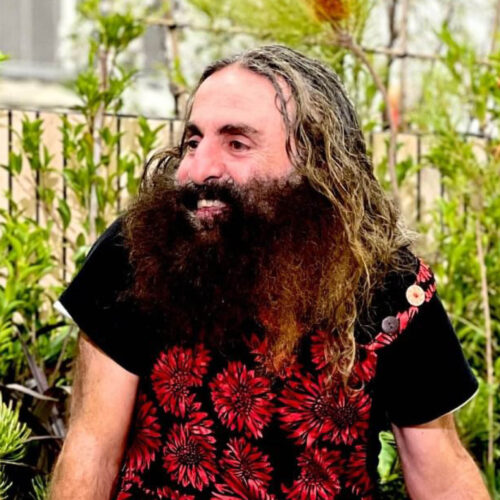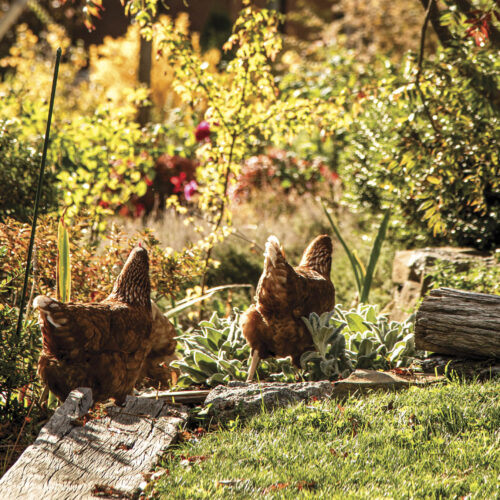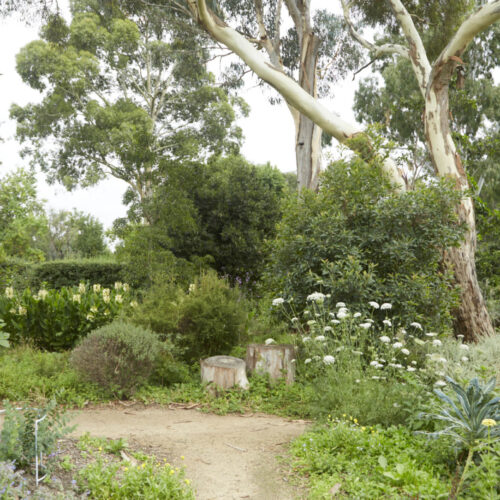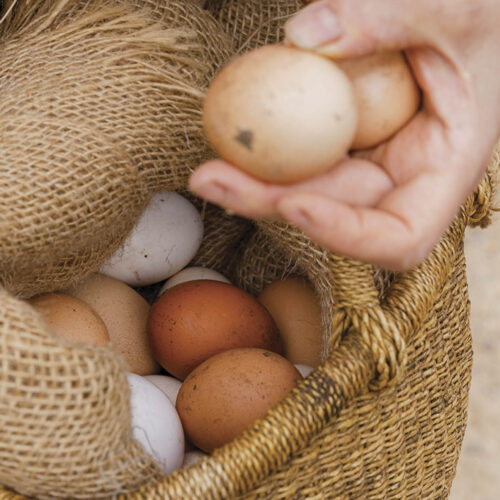Permaculture Providers
2012-04-02T03:01:32+10:00
Annemarie and Graham Brookman have spent 30 years creating a remarkable permaculture property near the Barossa Valley that produces more than 160 varieties of fruit, vegetables and nuts, and provides a working model for sustainable living, writes SIMON WEBSTER.
Graham and Annemarie Brookman are busy people. As well as growing more than 160 varieties of vegetables, fruit and nuts, which they sell at a farmers’ market and other ethical outlets, they run workshops and courses, process some of their produce (turning second-grade apples into cider and vinegar, for example), make wine, perform farming trials and guide school groups around their property.
All this with the help of just two part-time workers, one day a week, and two or three WWOOFers (willing workers on organic farms) at certain times of the year.
Do they ever feel like they have taken on too much? “Every day,” Graham jokes. “We just need to
clone ourselves.”
The result of their endeavours is The Food Forest, a 15-hectare property near Gawler in South Australia. It is a rare thing: a functional, profitable permaculture farm, where the philosophy of permaculture originators Bill Mollison and David Holmgren has been turned into reality.
Laying down roots
In the 1970s, Graham and Annemarie, fresh out of agricultural college, travelled around Europe and Africa in a Kombi, searching for a model of sustainable agriculture that they could bring back to Australia.
It was here waiting for them when they returned home: Mollison and Holmgren had published Permaculture One, outlining a new design system for sustainable living. The Brookmans signed up for a course with Mollison, drew up a design for their newly acquired property and, in 1983, got to work.
“We had a mission statement,” says Graham. “It was to try out permaculture and see if it did work. And to build a beautiful place to live, a highly productive place, and share any information that we got out of it.
“We wanted it to be a great place for the kids to grow up and for us to enjoy, and a dynamic system proving that you can farm organically, and do better than that – [we wanted to show] you can farm sustainably, and make money doing it.”
The experiment has been a resounding success. The farm is increasingly productive and profitable, and the Brookmans, now 62 (Graham) and 55 (Annemarie) are sharing their experiences through courses and videos, and their two children have had happy upbringings, left home and started careers in environmental fields.
“Permaculture has been extraordinarily successful and exciting and it has brought us together with a wonderful community of people,” says Graham. “The key part of permaculture – setting up productive ecosystems – has worked magnificently.”
However, Graham acknowledges that their conventional agricultural training helped: “A PDC [Permaculture Design Certificate course] can’t possibly in 10 days turn a person into a professional agriculturist. Permaculture gives people a set of overarching ethics and a philosophy and good design principles, but production skills have to be learnt too.”
Infertile beginnings
Graham says the block had been continuously cropped with cereal crops for many years: “There was awful hardpan 7cm down. The soil was less than 1 per cent carbon. It was like a concrete tennis court.”
There were only two trees. “One boxthorn on the fence line and one eucalypt in a corner,” says Annemarie. This meant the property was also lacking life.
“We would have lunch in the shade of the big red gums down by the river and we noticed a hugely increased birdlife on the riverbank that simply wasn’t present on our block,” says Annemarie.
So the regeneration of the property began with planting trees and shrubs – as windbreaks and bird and insect attractants. And when the Brookmans introduced animals it wasn’t sheep or cattle, but geese and an endangered species of bettong, both of which went into about eight hectares that had been enclosed with fox-proof fencing.
Both have been a great success. The geese provide fertility and meat, and the bettong not only digs up and eats oxalis weed bulbs, but buries native plant seeds and forgets about some of them, leading to native trees popping up without the landholders having to do a thing.
The Brookmans refer to the permaculture principles – care for the land, care for people and share the surplus – every day.
“You have a choice,” says Annemarie. “Is it good for the planet? Is it good for the community and, in terms of consumption, does it stack up? It becomes a basis for decision making.”
In the zone
The Food Forest is designed according to the permaculture principle of zones. Elements in the system that require most management are set up in the zones closest to the house. Graham and Annemarie have laid out their property as follows:
Zone 0; The 170-year-old heritage-listed stone cottage has been retrofitted with grid-feeding photovoltaic panels, solar hot water, a slow combustion heater and transparent panels in the verandah roof at window points.
An extension containing a catering kitchen and large dining area has been constructed from straw bale, stone, besser bricks and galvanised iron, built according to passive solar design principles, with windows and roof aligned to let the winter sun in and keep the summer sun out. An internal stone wall stores heat during winter days and releases it at night.
A 22,000-litre tank collects rainwater from the roof and provides the family’s water needs. Grey and black water from the house passes through a regular septic tank before flowing through a gravel-filled reedbed, which purifies it to the point that it can be automatically applied by subsurface irrigation to the pome fruit orchard – all with council approval and “with magnificent results”, says Graham.
WWOOFers’ accommodation (a strawbale studio) and a learning centre (a retrofitted stone barn) share a toilet block, with large numbers of people using the facilities irregularly. A composting toilet easily handles shock loads and produces compost for the bottom of (non-food) tree planting holes. The modest amount of grey water generated from the learning centre is cleaned by a small reedbed and irrigates a plantation of structural bamboo.
Zone 1; As well as outdoor cooking and eating areas surrounded by herb and vegetable gardens for home use, zone 1 is home to the Brookmans’ market garden, in which they grow produce for the Adelaide Showground Farmers’ Market. At about 1000 square metres, the garden could easily be a full-time job, but it is set up to be a time-efficient enterprise.
Annemarie and the two part-time workers are “in there every Friday, one week for picking and one week for maintenance,” she says. “During the week it’s a few hours here and there. In spring we might do two full days a week. The idea of a seven-day-a-week market garden doesn’t appeal to me at all.”
The garden has been designed so a tractor can be used to spread compost, slash crops and cultivate, keeping labour hours down. Plus, after much trial and error the Brookmans have settled on plants that are easy to grow and can be mulched so they don’t need
much weeding.
“Tedious plants like carrots and beetroot we don’t grow,” says Annemarie. “In our environment they stay small for too long and get taken over by weeds.”
Sweetcorn, capsicum, chilli, eggplant, basil, silverbeet, zucchini, pumpkin and parsley are among the crops that have passed the test.
The Brookmans practise crop rotation, grow green manures and feed only with compost, wood ash and occasionally fish emulsion. They stay ahead of pests by avoiding key pest seasons (for example, growing brassicas only in winter, when the cabbage white butterfly tends to be dormant).
Insect-attracting plants such as fennel encourage good bugs, and a proportion of nettles (as long as they are not inhibiting vegie growth) are allowed to go to seed. These are valued for the organic matter they provide when incorporated into the soil.
Crop residues also go back into the soil, where they compost in situ, rather than being taken away to a compost heap. (The Brookmans do make their own compost when they have large amounts of byproduct, such as apple pulp from making cider, but they also buy in a large load – 240 cubic metres – every two years to spread over orchards and gardens.)
Zone 2; The orchard here is a permaculture food forest – a diverse mix of edible, insect-attracting and otherwise useful plants laid out in an informal design. It is home to fruit trees that require good irrigation and fertility, such as figs, avocados and citrus.
“We use dripper tape, so virtually the whole surface is irrigated,” says Graham. Water for irrigation in this Mediterranean climate comes from a bore; the Brookmans try to balance their H²O books by pumping from the Gawler River when it is flowing well and returning water to the shallow aquifer.
A dozen chickens have limited access to this food forest, and are at other times let out into paddocks. They are based in a stationary chook house with a run around it that has gates to different parts of the farm.
“Substandard vegies and weeds get hurled straight into the chook run and the hens work them over and produce a wonderful mix of litter and manure that is added to compost heaps,” says Graham.
Zone 3; “Zone 3 represents the bulk of the property: the orchards, the carobs and pistachios, almonds and pecans, walnuts and so on,” says Graham. These are laid out more like conventional orchards than permaculture food forests. Having the trees in rows helps with harvesting, irrigation and netting.
Unconventionally, the orchards are mixed – with apples, pears and stonefruit all in the one block, for example – and have insect-attracting trees such as melaleucas and leptospermums planted within the rows. Geese forage between trees.
The fruit and nut trees are not mulched but spread with compost annually. The nuts have become the Brookmans’ main crops, particularly the pistachios. However, that may be about to change.
“Because winters are getting warmer the pistachio flower buds are not getting enough chill, so they don’t feel they’ve been through a proper winter and they refuse to flower when spring does come,” says Graham. The search is on for pistachio cultivars that can better cope with the new conditions.
The Brookmans are also experimenting with other species, including carobs, jujubes and sapotes. Native oranges might also prove a winner – this year they are cropping for the first time, 21 years after they were planted.
Also part of zone 3 are the cereal crops grown in a couple of paddocks leased from a neighbour. Graham is experimenting with mixed wheat varieties to identify which cultivars will compete best with weeds, letting them fight it out for themselves to prove which are best suited to organic growing at The Food Forest.
Zone 4; A woodlot/forest comprises the Brookmans’ zone 4. “Canary Island pine is the species we’ve used for sawlogs,” says Graham. “We also have red gums and casuarinas for pole timber and firewood. The pines are interplanted with oaks, which will take over the forest as the pines are harvested.”
Zone 5; The wilderness zone extends into the property from the riverbank, leading to a triangular patch of native vegetation right in the middle of the block. Trees were chosen so that there is nectar and pollen year-round.
This effective set-up ensures that birds and beneficial insects not only want to visit the property – they want to stay there. It also makes life easier for the beekeeper who uses the Brookmans’ native forest to make his honey. The presence of flowers all year means he never has to move his hives.
The abundance of life attracted by these patches of native vegetation is one of the reasons the Brookmans can grow 160 species without resorting to insecticides – even organic ones.

